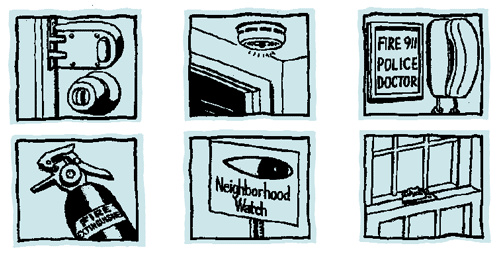|
Unit 4: Your home
is your castle
Lesson 1: Protecting and maintaining
your home
Protecting your property from fire and
theft
After you have moved into your new home,
it is important to protect your property. You can protect
your home against fire and theft by following a few safety
rules.
1. Keep a list of emergency phone numbers
near your telephone. Be sure to include telephone numbers
for the police, doctor, hospital, and fire station.
2. Put a smoke detector on the ceiling
out- side bedroom doors and near the living room. You will
need at least one on each floor of your home. Check them
often to make sure they work.
3. Keep a fire extinguisher in or near
the kitchen. If you have a large house, place a fire extinguisher
on each floor, in the garage, and in the basement.
4. Make sure that all doors and windows
have locks. It’s a good idea to change the locks as
soon as you move into your new house.
5. Join the neighborhood watch program
in your community. Neighbors try to prevent robberies by
watching their streets and then warning each other (and
sometimes the police) if they see strange or suspicious
people or cars in the neighborhood.
Safety rules
Which safety rules are being followed
in the pictures below? Why is it important to follow these
rules? Try to add some safety rules to this list.

Maintaining your home
When you rent a home, your landlord is
responsible for repairs. However, if you own a home, you
are responsible for maintenance and repairs. Maintaining
your home may take more time and be more expensive than
you think. Your roof may start to leak, or you may need
to replace a furnace. Even the cost of minor repairs can
add up. Your household budget should include money for both
routine maintenance and emergency repairs.
Whether you move into a new home or an
older home, it is important to know how everything in your
house works, including the electricity, plumbing, large
appliances, and heating system. In case of an emergency,
you should know how to cut off the water and gas supply.
You should also know where the fuse box and main electrical
switch are located and how they work.
You can usually get this information from
a home inspector. Before you close on the purchase of your
home, you can hire a home inspector to check the mechanical
and
structural condition of the home and give you a written
report on it. It is a good idea
to make a list of questions for the inspector and to write
the answers in a notebook.
Do-it-yourself repairs
You can save money by doing minor repairs
yourself. To learn how to make repairs, you can take a home
repair course through your local adult education program.
Another possibility is to go to the library and borrow some
books on do-it-yourself home repairs.
Previous
Page | Next Page
|